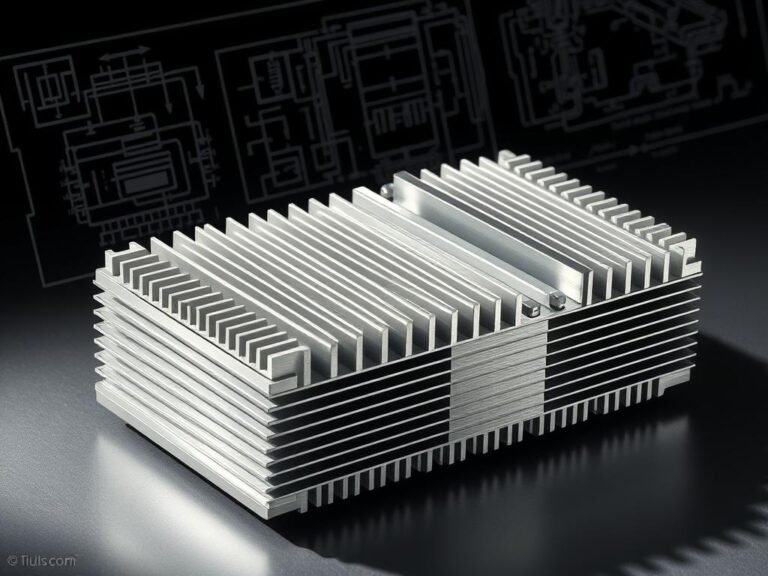Aluminum is an important material in modern industry. Its melting point is crucial for its processing and application. It enables precise manufacturing.
The melting point of aluminum helps develop optimal manufacturing processes. This allows us to fully utilize its material properties. Aluminum is ideal for lightweight construction due to its lightness and strength.
The combination of metallurgy and modern processing techniques creates innovative solutions. These are used in aerospace, the automotive sector, and construction.
Understanding the melting point of aluminum
The melting point of aluminum is very important for precision in lightweight construction. When aluminum is heated to about 660 °C, it becomes liquid. This low melting point makes processing more efficient than steel.

The thermal properties of aluminum are critical for manufacturing components. Processing aluminum is more energy-efficient because of its low melting point. Different alloys can alter the melting point, allowing customization for specific requirements.
660 °C and its significance
The melting point of 660 °C is not just a physical value. It also has practical implications for the processing and application of aluminum. In manufacturing aluminum parts, precise temperature control is essential to ensure the quality of the final products.
The most common methods for temperature measurement and control in industrial melting processes include thermocouples and pyrometers. These technologies enable precise monitoring of the melting temperature and contribute to quality assurance.
Furthermore, the solidification temperature and solidification interval of aluminum are of great importance for shaping components. By understanding these thermal properties, manufacturers can optimize their product characteristics and develop innovative applications.
Advantages in manufacturing
Aluminum has a low melting point. This makes it ideal for lightweight constructions. It is lightweight and easy to process.
Lightweight applications
Aluminum is used in various processes such as die casting and extrusion. Its melting point significantly influences processing.
Some advantages of aluminum are:
- It saves weight
- It is strong but lightweight
- It is corrosion-resistant thanks to the oxide layer
| Manufacturing process | Advantages | Applications |
|---|---|---|
| Die casting | High precision, complex geometries | Automotive industry, aerospace |
| Extrusion | High productivity, flexible profiles | Construction industry, vehicle manufacturing |
| Forging | High strength, improved surfaces | Aerospace, high-performance applications |
Corrosion resistance
The oxide layer on aluminum protects against corrosion. This protective layer is affected by heat. It can also be improved through special treatments.
Aluminum is sustainable. It is lightweight and corrosion-resistant. This makes it an ideal material for many applications.

Machining challenges
There are many challenges when machining aluminum. It requires special solutions. Many difficulties must be carefully planned.
Tool wear
A major problem is tool wear. Aluminum is soft and tends to stick to tools. Therefore, choosing the right tools is very important.
An appropriate coating can reduce wear. It is also important to properly set the cutting speed and feed rate. This reduces the stress on the tools.
| Tool material | Coating | Cutting speed |
|---|---|---|
| Carbide | Titan-Nitrid | 200 m/min |
| Cutting ceramics | Aluminium-Oxid | 300 m/min |
| Diamond coated | Diamond | 400 m/min |
Temperature control
Temperature control is important when machining and welding aluminum. Overheating can damage material properties and cause deformations.
There are various cooling methods, such as Liquid cooling and Air cooling. The correct method depends on the processing requirements.
Precise temperature control is crucial in the heat treatment of aluminum. Modern processes like additive manufacturing require accurate temperature control for high quality.
Applications
Aluminum is popular in many industries. It is lightweight, strong, and corrosion-resistant. This makes it a favorite in the industry.
Applications in aerospace
Im Aircraft manufacturing uses aluminum for fuselages, wings, and structures. Special alloys are very important for aerospace.
Automotive industry and body parts
In the automotive sector, aluminum is used for body parts, engine blocks, and wheels. It helps make vehicles lighter. This reduces fuel consumption and CO2 emissions.
Heat dissipation in electronics
In electronic enclosures, aluminum is ideal because of its heat dissipation and shielding properties. Modern processes enable complex enclosure shapes. These cool electronic components.
The many aluminum applications reveal its great potential. It is used for future developments and new areas.


